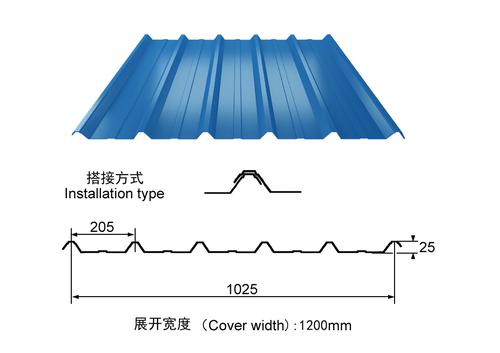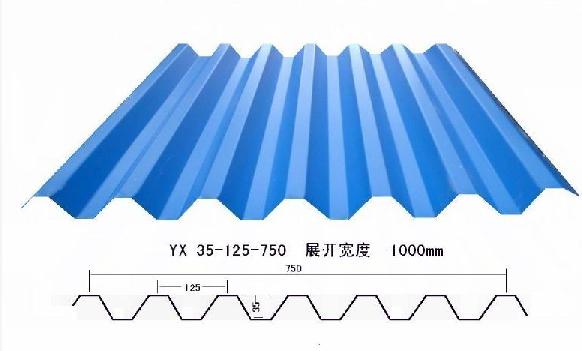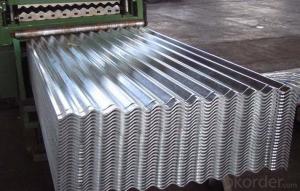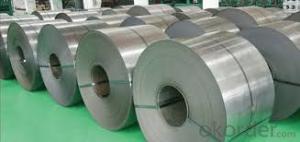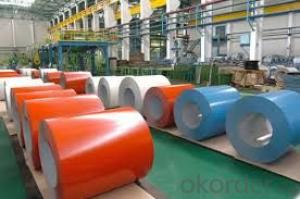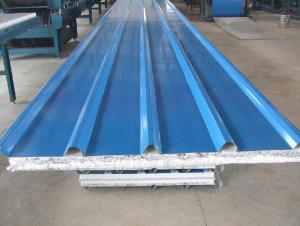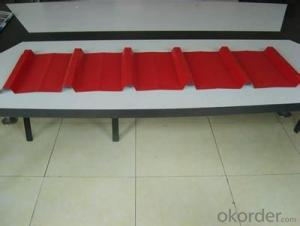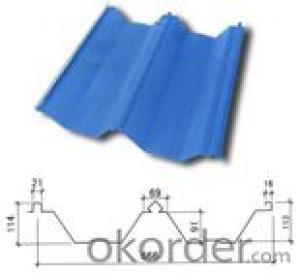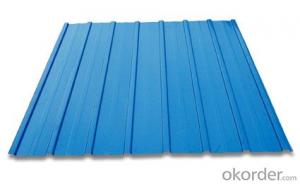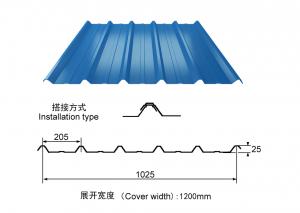CORRIGATED SHEET
- Loading Port:
- Tianjin
- Payment Terms:
- TT OR LC
- Min Order Qty:
- -
- Supply Capability:
- 1000 m.t./month
OKorder Service Pledge
Quality Product, Order Online Tracking, Timely Delivery
OKorder Financial Service
Credit Rating, Credit Services, Credit Purchasing
You Might Also Like
Product Name:corrugated steel roofing sheet
Effective Width:650mm to 1250mm
Thickness:0.13mm-0.8mm
Material PPGI/PPGL steel coil
Coating:Z30-Z275,AZ30-AZ180
Color:white,blue or any RAL colors
length:1m-11.8m according to the container
top color coating:12um-25um
Back color coating:7um-10um
HRB:50-95
Base plate:PRE-PAINTED ALUZINC STEEL COIL,PRE-PAINTED GALVANIZED STEEL COIL
- Q: What's the difference between low carbon steel and cold rolled steel?
- Finally, low carbon steels do not always have to be cold rolled. I can only pass through hot rolling. See what you do.
- Q: What is the typical yield strength of stainless steel sheets?
- The typical yield strength of stainless steel sheets can vary depending on the grade and thickness of the material. However, on average, stainless steel sheets have a yield strength ranging from 30,000 to 80,000 pounds per square inch (psi). It is important to note that different grades of stainless steel, such as 304, 316, or 430, will have different yield strengths. Additionally, the thickness of the sheet can also affect the yield strength, with thinner sheets generally having lower yield strengths compared to thicker sheets. Therefore, it is recommended to consult the specific grade and thickness specifications provided by the manufacturer or supplier to determine the exact yield strength of a particular stainless steel sheet.
- Q: Can steel sheets be used for structural purposes?
- Yes, steel sheets can be used for structural purposes. Steel sheets are strong, durable, and have high load-bearing capacity, making them suitable for various structural applications such as roofing, flooring, walls, and supports in buildings, bridges, and other structures.
- Q: Excuse me, what's the difference between cold rolled steel plate and hot plate in steel plate?
- In general, cold rolled steel has better strength, hot rolled steel plate has better ductility. The general thickness of cold rolled is relatively small, can have a larger thickness. Cold rolled steel plate surface quality, appearance and dimensional accuracy than the hot plate, and the thickness of the product right rolling thin to about 0.18mm, so it is popular for. The acceptance of the products, can ask professional personage.
- Q: Can steel sheets be perforated for ventilation purposes?
- Yes, steel sheets can be perforated for ventilation purposes. Perforations can be made in steel sheets to allow airflow and improve ventilation in various applications such as HVAC systems, architectural designs, industrial equipment, and more.
- Q: What is the recommended storage method for the steel sheets?
- The recommended storage method for steel sheets is to store them in a dry and well-ventilated area. It is important to keep the steel sheets away from moisture and direct sunlight, as these factors can cause rust and degradation of the material. Stacking the sheets on pallets or racks, with sufficient spacing in between, can help prevent any potential damage. Additionally, it is advisable to cover the sheets with a protective material, such as a tarp or plastic wrap, to further safeguard them from dust and other contaminants. Regular inspection and maintenance of the storage area, as well as keeping an inventory of the sheets, can help ensure their longevity and usability.
- Q: How are steel sheets protected during storage and handling?
- Steel sheets are typically protected during storage and handling through various measures such as applying a protective coating, using separators to prevent direct contact, and storing them in a controlled environment to avoid moisture and corrosion.
- Q: Are the steel sheets suitable for architectural applications?
- Indeed, architectural applications can certainly make use of steel sheets. Steel, being a versatile material, presents numerous benefits for architectural purposes. It possesses strength, durability, and the ability to withstand harsh weather conditions, thus making it an excellent choice for various architectural elements like roofing, cladding, and facades. Furthermore, steel sheets provide architects with design flexibility, enabling the creation of unique and innovative structures. Moreover, steel is an environmentally sustainable material due to its recyclability and long lifespan, making it an eco-friendly option for architectural applications. All in all, steel sheets serve as a dependable and versatile choice for architects who desire to incorporate structural integrity, aesthetic allure, and sustainability into their designs.
- Q: How do steel sheets perform in terms of scratch resistance?
- Renowned for their exceptional ability to resist scratches, steel sheets are widely recognized for their strong and durable nature. This quality makes them highly suitable for a multitude of applications where they may come into contact with objects or surfaces that could potentially cause damage. Moreover, steel sheets possess the capacity to endure regular wear and tear, rendering them particularly suitable for demanding environments with heavy usage. Furthermore, the scratch resistance of steel sheets can be further enhanced by applying coatings or finishes, thereby achieving an even higher level of protection. In summary, the outstanding scratch resistance of steel sheets has earned them a well-deserved reputation as a reliable choice for a diverse range of industrial and commercial purposes.
- Q: Are the steel sheets suitable for shipbuilding?
- Yes, steel sheets are highly suitable for shipbuilding. Steel is a versatile and durable material that possesses excellent properties for marine applications. It has a high strength-to-weight ratio, allowing for the construction of robust and sturdy vessels while keeping the overall weight low. Steel sheets also have high tensile strength, which ensures the ship's structural integrity and resistance to forces exerted by waves, wind, and other external factors. Additionally, steel is highly resistant to corrosion, making it ideal for withstanding the harsh saltwater environment. Its fire-resistant properties further enhance the safety of ships. Given these advantages, steel sheets are widely used in shipbuilding and have proven to be reliable and efficient in constructing various types of vessels, from cargo ships to cruise liners and naval warships.
Send your message to us
CORRIGATED SHEET
- Loading Port:
- Tianjin
- Payment Terms:
- TT OR LC
- Min Order Qty:
- -
- Supply Capability:
- 1000 m.t./month
OKorder Service Pledge
Quality Product, Order Online Tracking, Timely Delivery
OKorder Financial Service
Credit Rating, Credit Services, Credit Purchasing
Similar products
Hot products
Hot Searches
Related keywords




